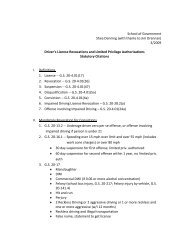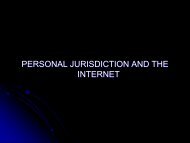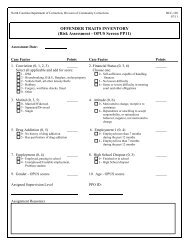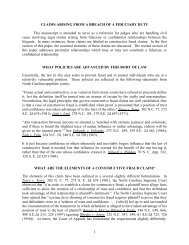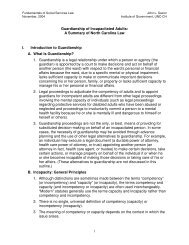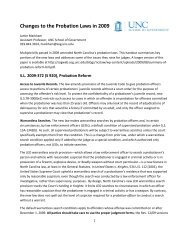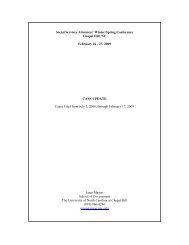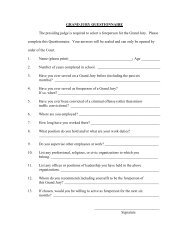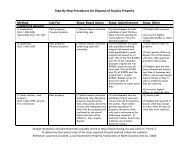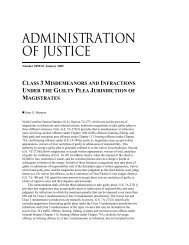AOJ Bulletin 2002/04 - University of North Carolina at Chapel Hill
AOJ Bulletin 2002/04 - University of North Carolina at Chapel Hill
AOJ Bulletin 2002/04 - University of North Carolina at Chapel Hill
You also want an ePaper? Increase the reach of your titles
YUMPU automatically turns print PDFs into web optimized ePapers that Google loves.
administr<strong>at</strong>ion<br />
<strong>of</strong> justice<br />
Number <strong>2002</strong>/<strong>04</strong> March <strong>2002</strong><br />
ADMINISTRATIVE PER SE REQUIREMENTS<br />
AND IGNITION INTERLOCKS IN IMPAIRED<br />
DRIVING OFFENSES<br />
■ James C. Drennan<br />
In 1999, the <strong>North</strong> <strong>Carolina</strong> General Assembly enacted two separ<strong>at</strong>e provisions to regul<strong>at</strong>e the<br />
behavior <strong>of</strong> convicted impaired drivers. Both impose more restrictive conditions on those<br />
drivers’ licenses than the conditions th<strong>at</strong> are applicable to the general public. One imposes, as<br />
a condition <strong>at</strong>tached to the restor<strong>at</strong>ion <strong>of</strong> the convicted person’s drivers license, a per se<br />
alcohol concentr<strong>at</strong>ion th<strong>at</strong> is lower than the level applicable to the general public. A per se<br />
alcohol concentr<strong>at</strong>ion is the level above which it is unlawful, in and <strong>of</strong> itself, to drive a vehicle<br />
<strong>at</strong> any relevant time after consuming the alcohol th<strong>at</strong> causes the elev<strong>at</strong>ed alcohol<br />
concentr<strong>at</strong>ion. (A relevant time is any time in which the alcohol being tested is alcohol th<strong>at</strong><br />
was in the person’s body before or during the driving.) The second provision requires the<br />
driver to install ignition interlock devices on his or her vehicles. Ignition interlock devices are<br />
instruments <strong>at</strong>tached to the ignition system <strong>of</strong> a vehicle th<strong>at</strong> measure a potential driver’s<br />
alcohol concentr<strong>at</strong>ion and prevent persons with more than a specified amount <strong>of</strong> alcohol from<br />
starting the vehicle or from continuing to oper<strong>at</strong>e the vehicle.<br />
These provisions are neither congruent nor mutually exclusive. Some drivers will be<br />
subject to one, some to the other, and some to both, although many more people are subject to<br />
the per se levels than are subject to the interlock requirements.<br />
This memo discusses each provision. It will list the drivers who are covered by each<br />
provision and the length <strong>of</strong> time the provision is applicable. It will also discuss the methods<br />
by which each is enforced, and the consequences <strong>of</strong> viol<strong>at</strong>ion <strong>of</strong> each provision. Finally it will<br />
discuss the effects when a person is subject to both provisions <strong>at</strong> the same time.<br />
Lower Per Se Levels<br />
GS 20-19(c3)-(c6) establishes the lower per se levels and the enforcement procedures<br />
applicable to them. One important point about these st<strong>at</strong>utes needs to be emphasized. These<br />
st<strong>at</strong>utes do not cre<strong>at</strong>e a new kind <strong>of</strong> DWI criminal <strong>of</strong>fense. Drivers who exceed these new per<br />
se levels do not commit the <strong>of</strong>fense <strong>of</strong> driving while impaired. The primary enforcement
Administr<strong>at</strong>ion <strong>of</strong> Justice <strong>Bulletin</strong> No. <strong>2002</strong>/<strong>04</strong> March <strong>2002</strong><br />
mechanism for this new per se level is through the<br />
Division <strong>of</strong> Motor Vehicles (DMV) administr<strong>at</strong>ive<br />
hearing process. The result <strong>of</strong> th<strong>at</strong> process is th<strong>at</strong> the<br />
driver’s license may be revoked, although in some<br />
cases <strong>of</strong>ficers may charge the <strong>of</strong>fender with the<br />
criminal <strong>of</strong>fense <strong>of</strong> driving in viol<strong>at</strong>ion <strong>of</strong> a restriction<br />
on the person’s license, in viol<strong>at</strong>ion <strong>of</strong> GS 20-7(e).<br />
Applicability<br />
People who lose their drivers license for convictions <strong>of</strong><br />
certain impaired driving <strong>of</strong>fenses are subject to the<br />
lower per se levels when their license is restored. This<br />
requirement applies to drivers license restor<strong>at</strong>ions for<br />
convictions <strong>of</strong> <strong>of</strong>fenses committed on or after July 1,<br />
2000.<br />
Being subject to this per se level means th<strong>at</strong> the<br />
person may not drive a vehicle on a highway or public<br />
vehicular <strong>at</strong> any relevant time after the driving with an<br />
alcohol concentr<strong>at</strong>ion th<strong>at</strong> exceeds the limits specified<br />
for his or her license. For this purpose the definitions<br />
<strong>of</strong> vehicle, highway, public vehicular area, alcohol,<br />
alcohol concentr<strong>at</strong>ion, and relevant time after the<br />
driving are the same as for all other impaired driving<br />
<strong>of</strong>fenses. Each <strong>of</strong> those words or phrases is defined in<br />
GS 20-4.01. The <strong>of</strong>fenses th<strong>at</strong> are covered by this<br />
provision, the applicable per se level, and the dur<strong>at</strong>ion<br />
<strong>of</strong> the restrictions are as follows:<br />
1. Driving while impaired (GS 20-138.1). These<br />
<strong>of</strong>fenders are subject to the per se level <strong>of</strong><br />
0.<strong>04</strong> for three years if the person’s license has<br />
not been previously restored for a revoc<strong>at</strong>ion<br />
based on a DWI conviction, and to a per se<br />
level <strong>of</strong> 0.00 if the person has a previous<br />
license restor<strong>at</strong>ion for a DWI conviction. This<br />
0.00 level applies to the person for three years<br />
unless the license is permanently revoked<br />
under GS 20-19(e); in th<strong>at</strong> case, it applies for<br />
seven years.<br />
2. Driving a commercial vehicle while impaired<br />
(GS 20-138.2). These <strong>of</strong>fenders are subject to<br />
a per se level <strong>of</strong> 0.00 for a period <strong>of</strong> three<br />
years, unless the license is permanently<br />
revoked; in th<strong>at</strong> case it applies for seven<br />
years.<br />
3. Driving while less than 21 years <strong>of</strong> age after<br />
consuming alcohol or drugs (GS 20-138.3).<br />
These <strong>of</strong>fenders are subject to a per se level<br />
<strong>of</strong> 0.00 until their 21 st birthday.<br />
4. Vehicular homicides involving impaired<br />
driving (felony de<strong>at</strong>h by vehicle—GS 20-<br />
141.4—, manslaughter, or negligent<br />
homicide). These <strong>of</strong>fenders are subject to a<br />
per se level <strong>of</strong> 0.00 for a period <strong>of</strong> seven<br />
years.<br />
5. Offenses by residents <strong>of</strong> this st<strong>at</strong>e, which<br />
occur in other st<strong>at</strong>es or in federal court, are<br />
substantially similar to those listed in 1-4<br />
above and which result in license revoc<strong>at</strong>ions<br />
under GS 20-23 and -23.2, will be tre<strong>at</strong>ed in<br />
the same manner as if they had occurred in<br />
this st<strong>at</strong>e. For example, a person convicted <strong>of</strong><br />
impaired driving in another st<strong>at</strong>e who loses<br />
his license in this st<strong>at</strong>e as a result <strong>of</strong> th<strong>at</strong><br />
conviction will be subject to the per se level<br />
<strong>of</strong> 0.<strong>04</strong> the first time he or she receives a<br />
restored license, for a period <strong>of</strong> three years, as<br />
described in no. 1. above. For a second such<br />
restor<strong>at</strong>ion, the level is reduced to 0.00 and<br />
the period remains three years. For purposes<br />
<strong>of</strong> counting prior restor<strong>at</strong>ions, revoc<strong>at</strong>ions<br />
based on both in-st<strong>at</strong>e and out-<strong>of</strong>-st<strong>at</strong>e<br />
convictions, as defined in G.S. 20-4.01, count.<br />
Restrictions<br />
When a person receives a restored license subject to<br />
this requirement, the DMV will assign a restriction<br />
code to the person’s license, similar to the restrictions<br />
placed on licenses for persons requiring corrective<br />
lenses (which is restriction # 1). The restrictions are as<br />
follows:<br />
<br />
<br />
<br />
<br />
19—means th<strong>at</strong> the person is subject to a per<br />
se level <strong>of</strong> 0.<strong>04</strong><br />
20—means th<strong>at</strong> the person is subject to a per<br />
se level <strong>of</strong> 0.<strong>04</strong> and in addition must have an<br />
ignition interlock device on his or her vehicle<br />
21—means th<strong>at</strong> the person is subject to a per<br />
se level <strong>of</strong> 0.00<br />
22—means th<strong>at</strong> the person is subject to a per<br />
se level <strong>of</strong> 0.00 and in addition must have an<br />
ignition interlock device on his or her vehicle<br />
There are two other restriction codes th<strong>at</strong> may be<br />
present on drivers’ licenses.<br />
<br />
*9—means th<strong>at</strong> the person has a conditionally<br />
restored license th<strong>at</strong> is subject to some<br />
restriction. The restriction could reflect a<br />
license conditionally restored under GS 20-<br />
19(d) or (e) for revoc<strong>at</strong>ions based on multiple<br />
DWI convictions, a license conditionally<br />
restored under GS 20-19(i) for a permanent<br />
revoc<strong>at</strong>ion based on an alcohol-involved<br />
2
March <strong>2002</strong> Administr<strong>at</strong>ion <strong>of</strong> Justice <strong>Bulletin</strong> No. <strong>2002</strong>/<strong>04</strong><br />
<br />
conviction <strong>of</strong> de<strong>at</strong>h by vehicle or<br />
manslaughter, or a restriction rel<strong>at</strong>ed to a<br />
person’s medical condition. The specific<br />
restriction is listed on the back <strong>of</strong> the license.<br />
23—means th<strong>at</strong> the person is subject to an<br />
interlock requirement, but is not subject to a<br />
lower per se level (other than as a part <strong>of</strong> the<br />
interlock requirement). Licenses subject to<br />
this restriction will be rare, since in virtually<br />
every case in which a license is restored<br />
subject to an interlock requirement, it will<br />
also be subject to a lower per se requirement.<br />
Licenses subject only to these last two restrictions<br />
are not subject to the enforcement provisions <strong>of</strong> the<br />
new per se laws.<br />
In addition to the lower per se level, a person<br />
seeking restor<strong>at</strong>ion must agree to two other conditions<br />
to be eligible for a restored license. First, the person<br />
must agree to submit to a chemical analysis in<br />
accordance with the procedures established in GS 20-<br />
16.2 to obtain th<strong>at</strong> analysis when a law enforcement<br />
<strong>of</strong>ficer has reasonable grounds to believe th<strong>at</strong> the<br />
person has driven in viol<strong>at</strong>ion <strong>of</strong> the restriction.<br />
Second, the person must agree to be transported to a<br />
test site if requested to do so by a law enforcement<br />
<strong>of</strong>ficer.<br />
Enforcement<br />
A person who is subject to these lower alcohol<br />
concentr<strong>at</strong>ions has a valid drivers license. The license<br />
is just restricted in the sense th<strong>at</strong> the driver may not<br />
drive if his or her alcohol concentr<strong>at</strong>ion exceeds the<br />
level specified in the restriction. Wh<strong>at</strong> happens if the<br />
person drives in a manner th<strong>at</strong> viol<strong>at</strong>es th<strong>at</strong> restriction?<br />
This discussion applies only to a driver whose license<br />
is subject only to the lower alcohol concentr<strong>at</strong>ion<br />
restriction. If the person also is subject to the interlock<br />
requirement, different procedures, discussed below,<br />
apply. The discussion also does not apply to a person<br />
who is charged with impaired driving and with<br />
viol<strong>at</strong>ion <strong>of</strong> this restriction; th<strong>at</strong> situ<strong>at</strong>ion is also<br />
discussed below.<br />
It is important first to note wh<strong>at</strong> does not happen.<br />
A viol<strong>at</strong>ion <strong>of</strong> the restriction is not an impaired driving<br />
criminal <strong>of</strong>fense. It is also not the <strong>of</strong>fense <strong>of</strong> driving<br />
while license revoked, as would be true if the person<br />
viol<strong>at</strong>ed an interlock restriction (discussed below).<br />
Because there is no alcohol rel<strong>at</strong>ed charge associ<strong>at</strong>ed<br />
with a viol<strong>at</strong>ion <strong>of</strong> this restriction, there is also no civil<br />
revoc<strong>at</strong>ion (CVR) under GS 20-16.5.<br />
GS 20-19(c3)-(c6) provides a procedure for<br />
dealing with viol<strong>at</strong>ions other than refusals to submit to<br />
a chemical analysis. Refusals are discussed below. A<br />
law enforcement <strong>of</strong>ficer who believes th<strong>at</strong> the driver is<br />
viol<strong>at</strong>ing the restriction may request th<strong>at</strong> the person<br />
accompany him or her to the place where the chemical<br />
analysis will be administered. At the test site, a<br />
chemical analysis administered pursuant to GS 20-16.2<br />
(and 20-139.1) may be administered. If the driver’s<br />
alcohol concentr<strong>at</strong>ion exceeds the applicable per se<br />
level, the <strong>of</strong>ficer is directed to complete an affidavit<br />
(Form AOC-CVR-1) and send it to the DMV.<br />
The DMV, when it receives the affidavit, if it<br />
properly alleges a viol<strong>at</strong>ion, must revoke the driver’s<br />
license, effective ten days after the notice <strong>of</strong> revoc<strong>at</strong>ion<br />
is mailed to the driver. The driver is entitled to a<br />
hearing on the issue before a DMV hearing <strong>of</strong>ficer, but<br />
the hearing is limited to the following issues:<br />
1. Did the <strong>of</strong>ficer have reasonable grounds to<br />
believe th<strong>at</strong> the driver had viol<strong>at</strong>ed the per se<br />
restriction?<br />
2. Was the driver notified <strong>of</strong> his rights as<br />
required by GS 20-16.2(a)?<br />
3. Did the driver have a license restricted to a<br />
per se level?<br />
4. Did the person submit to a chemical analysis<br />
under GS 20-16.2 and if so, was the<br />
concentr<strong>at</strong>ion above the applicable per se<br />
level?<br />
Apparently the result <strong>of</strong> an alcohol screening test<br />
admininstered pursuant to GS 20-16.3 is not<br />
admissible to establish a viol<strong>at</strong>ion <strong>of</strong> this restriction.<br />
Alcohol screening tests are generally administered on<br />
the roadside using approved portable bre<strong>at</strong>h testing<br />
instruments. While useful to determine the existence <strong>of</strong><br />
alcohol in a person’s body, they serve a different<br />
purpose than the bre<strong>at</strong>h or blood analsyses done<br />
pursuant to the provisions <strong>of</strong> GS 20-16.2 and 20-139.1.<br />
The administr<strong>at</strong>ive per se restriction requires th<strong>at</strong> an<br />
“alcohol concentr<strong>at</strong>ion” (as th<strong>at</strong> term is defined in GS<br />
20-4.01) be established, and alcohol screening test<br />
results do not meet th<strong>at</strong> standard <strong>of</strong> precision. The only<br />
bre<strong>at</strong>h tests th<strong>at</strong> do are the chemical analyses<br />
(Intoxilyzers) administered pursuant to GS 20-16.2 and<br />
GS 20-139.1. In addition GS 20-16.3 (d) limits the use<br />
<strong>of</strong> alcohol screening test results to establish reasonable<br />
grounds for an implied consent <strong>of</strong>fense or as<br />
circumstantial evidence <strong>of</strong> the presence <strong>of</strong> drugs.<br />
Several criminal or infraction st<strong>at</strong>utes make it a<br />
viol<strong>at</strong>ion <strong>of</strong> law to drive with any alcohol in the body,<br />
and those st<strong>at</strong>utes specifically allow the use <strong>of</strong> alcohol<br />
screening tests to establish the presence <strong>of</strong> alcohol. GS<br />
20-138.2A; 20-138.2B; 20-138.3; 20-179.3(j). There<br />
3
Administr<strong>at</strong>ion <strong>of</strong> Justice <strong>Bulletin</strong> No. <strong>2002</strong>/<strong>04</strong> March <strong>2002</strong><br />
is no similar language in the st<strong>at</strong>utes establishing the<br />
administr<strong>at</strong>ive per se restrictions. These st<strong>at</strong>utes, read<br />
together, suggest th<strong>at</strong> alcohol screening test results are<br />
not admissible to establish a viol<strong>at</strong>ion <strong>of</strong> the<br />
administr<strong>at</strong>ive per se restriction.<br />
The procedures for the conduct <strong>of</strong> the hearing are<br />
contained in GS 20-19(c5) and (c6) and are similar to<br />
the procedures used for persons whose licenses are<br />
revoked for refusing to submit to a chemical analysis<br />
<strong>of</strong> his or her bre<strong>at</strong>h or blood, as specified in GS 20-<br />
16.2. The main differences between the two procedures<br />
are the issues th<strong>at</strong> are considered and the appeal rules.<br />
Appeals <strong>of</strong> the DMV’s ruling in the per se cases are<br />
subject to a much more limited review. In per se cases,<br />
the appeal is to the superior court. Th<strong>at</strong> court has the<br />
discretion to either review or decline to review the<br />
m<strong>at</strong>ter. If it grants a review, the review is on the record<br />
<strong>of</strong> the DMV’s hearing to determine if the DMV<br />
hearing <strong>of</strong>ficer followed proper procedure and made<br />
sufficient findings <strong>of</strong> fact to support the revoc<strong>at</strong>ion.<br />
There is no appeal beyond the superior court. In<br />
contrast, in refusals, the person has a right to a superior<br />
court review. The review is de novo. And the superior<br />
court’s decision may be appealed to the appell<strong>at</strong>e<br />
courts under GS 7A-27(b).<br />
Revoc<strong>at</strong>ion for viol<strong>at</strong>ion <strong>of</strong> restriction<br />
If the DMV concludes th<strong>at</strong> these questions are all<br />
answered positively, then the DMV must revoke the<br />
driver’s license for one year. If the person received his<br />
or her license on a conditional restor<strong>at</strong>ion before the<br />
full revoc<strong>at</strong>ion period had been served, then any time<br />
th<strong>at</strong> person had remaining on th<strong>at</strong> original revoc<strong>at</strong>ion<br />
must be served before the one-year revoc<strong>at</strong>ion begins.<br />
This hearing appears to be the primary method by<br />
which the legisl<strong>at</strong>ure intended for this restriction to be<br />
enforced. However, since the driver is subject to a<br />
restriction on his or her drivers license, it is possible<br />
th<strong>at</strong> the driver commits the <strong>of</strong>fense <strong>of</strong> driving a motor<br />
vehicle without complying with a valid license<br />
restriction. GS 20-7(e) makes th<strong>at</strong> <strong>of</strong>fense “the<br />
equivalent <strong>of</strong> oper<strong>at</strong>ing a motor vehicle without a<br />
license.” The legisl<strong>at</strong>ion establishing the lower per se<br />
levels is silent on this issue. It does establish a separ<strong>at</strong>e<br />
non-criminal enforcement mechanism th<strong>at</strong> results in<br />
the driver’s license being revoked. One construction <strong>of</strong><br />
th<strong>at</strong> st<strong>at</strong>ute is th<strong>at</strong> the legisl<strong>at</strong>ure specifically chose an<br />
administr<strong>at</strong>ive route to respond to viol<strong>at</strong>ions <strong>of</strong> this<br />
restriction. In the same enactment, the legisl<strong>at</strong>ure also<br />
added the new interlock requirements in which it did<br />
make viol<strong>at</strong>ions <strong>of</strong> the interlock restrictions a crime.<br />
Th<strong>at</strong> could be read to suggest th<strong>at</strong> the legisl<strong>at</strong>ure did<br />
not intend for the lower per se levels to be enforced<br />
using the criminal law. However, GS 20-7(e) can be<br />
read to include the per se level restrictions; it can be<br />
argued th<strong>at</strong> the legisl<strong>at</strong>ure did not need to specify any<br />
criminal enforcement mechanisms since there was<br />
already an applicable criminal <strong>of</strong>fense. Unless the<br />
legisl<strong>at</strong>ure clarifies its intent on this issue, it will have<br />
to be resolved by the courts.<br />
DWI and per se viol<strong>at</strong>ions in same case<br />
In some cases a person will be charged with a viol<strong>at</strong>ion<br />
<strong>of</strong> the per se restriction and will also be charged with<br />
impaired driving. In th<strong>at</strong> case, normally the charging<br />
<strong>of</strong>ficer will arrest the person for the impaired driving<br />
charge and follow the normal procedures for an arrest.<br />
Those procedures usually include the <strong>of</strong>ficer seeking a<br />
chemical analysis <strong>of</strong> the person’s bre<strong>at</strong>h, blood or other<br />
bodily substance. In th<strong>at</strong> case the <strong>of</strong>ficer should, in<br />
addition, insure th<strong>at</strong> the affidavit he or she completes<br />
(AOC-CVR-1) also indic<strong>at</strong>es th<strong>at</strong> the person charged is<br />
subject to a drivers license restriction. Each <strong>of</strong> those<br />
proceedings is independent <strong>of</strong> the other, and each can<br />
result in a revoc<strong>at</strong>ion <strong>of</strong> the person’s drivers license.<br />
GS 20-19(c3) specifies wh<strong>at</strong> happens if the person’s<br />
license had been returned conditionally before the<br />
person had fully served a revoc<strong>at</strong>ion for a second or<br />
subsequent impaired driving revoc<strong>at</strong>ion. In th<strong>at</strong> case<br />
any remaining period <strong>of</strong> the person’s original<br />
revoc<strong>at</strong>ion must be served, and the revoc<strong>at</strong>ion imposed<br />
for the person’s viol<strong>at</strong>ion <strong>of</strong> the per se restriction does<br />
not begin until th<strong>at</strong> period is served. Th<strong>at</strong> st<strong>at</strong>ute does<br />
not indic<strong>at</strong>e if a revoc<strong>at</strong>ion for an impaired driving<br />
convction would run concurrently with either <strong>of</strong> those<br />
other revoc<strong>at</strong>ions. The general rule, however, is th<strong>at</strong><br />
revoc<strong>at</strong>ions begin as soon as they are legally effective,<br />
and do not run consecutive to each other unless there is<br />
a specific st<strong>at</strong>ute th<strong>at</strong> delays the start <strong>of</strong> the revoc<strong>at</strong>ion<br />
period until other revoc<strong>at</strong>ions have been served.<br />
Refusal to submit to chemical analysis for<br />
per se viol<strong>at</strong>ion<br />
If a person subject to the per se viol<strong>at</strong>ion refuses to<br />
submit to a chemical analysis <strong>of</strong> his bre<strong>at</strong>h or blood<br />
after having been stopped or detained by an <strong>of</strong>ficer<br />
with probable cause to believe th<strong>at</strong> the person has<br />
viol<strong>at</strong>ed the per se restriction, the provisions <strong>of</strong> GS 20-<br />
16.2 apply to th<strong>at</strong> refusal. GS 20-19(c4). The result is<br />
th<strong>at</strong> the person’s license is revoked for one year, but<br />
the procedures to review th<strong>at</strong> decision are found in th<strong>at</strong><br />
st<strong>at</strong>ute and not in GS 20-19. The procedures are the<br />
4
March <strong>2002</strong> Administr<strong>at</strong>ion <strong>of</strong> Justice <strong>Bulletin</strong> No. <strong>2002</strong>/<strong>04</strong><br />
same ones used to enforce a refusal when a person is<br />
charged with DWI and then refuses a chemical<br />
analysis.<br />
Interlock<br />
There are two rel<strong>at</strong>ed provisions requiring an ignition<br />
interlock. Both apply only to persons convicted <strong>of</strong> the<br />
<strong>of</strong>fense <strong>of</strong> impaired driving under GS 20-138.1. Both<br />
requirements apply to drivers license actions based on<br />
convictions <strong>of</strong> <strong>of</strong>fenses committed on or after July 1,<br />
2000.<br />
The first, GS 20-179.3(g5) requires any limited<br />
privilege issued to a person who is found to have an<br />
alcohol concentr<strong>at</strong>ion <strong>of</strong> 0.16 or more to include<br />
conditions requiring an ignition interlock on the<br />
vehicle the defendant is authorized to drive. The<br />
second, GS 20-17.8, requires some persons seeking to<br />
have their drivers license restored after a revoc<strong>at</strong>ion for<br />
a conviction under GS 20-138.1 to install ignition<br />
interlocks on all vehicles they drive or th<strong>at</strong> are titled in<br />
their name.<br />
Limited driving privilege (GS 20-179.3(g5))<br />
This st<strong>at</strong>ute applies to any person revoked for a<br />
conviction <strong>of</strong> GS 20-138.1 who has an alcohol<br />
concentr<strong>at</strong>ion <strong>of</strong> 0.16 or more. There are several<br />
important things th<strong>at</strong> should be noted about those<br />
provisions.<br />
1. Because it applies to persons convicted <strong>of</strong> GS<br />
20-138.1, persons convicted <strong>of</strong> impaired<br />
driving <strong>of</strong>fenses in other st<strong>at</strong>es who apply for<br />
limited driving privileges in this st<strong>at</strong>e are not<br />
subject to the mand<strong>at</strong>ory ignition interlock<br />
requirement. A judge, however, may still<br />
require an interlock under GS 20-179(g3).<br />
2. Because the person must have an alcohol<br />
concentr<strong>at</strong>ion <strong>of</strong> 0.16 or more, a chemical<br />
analysis is required. If the person refuses a<br />
chemical analysis under GS 20-16.2, the<br />
mand<strong>at</strong>ory ignition interlock provision is not<br />
applicable. Again, a judge, in the exercise <strong>of</strong><br />
his or her discretion, may require an interlock.<br />
3. The requirement th<strong>at</strong> a specific alcohol<br />
concentr<strong>at</strong>ion be present is not a fact th<strong>at</strong> can<br />
be determined solely from the charge <strong>of</strong><br />
which the defendant is convicted. All th<strong>at</strong> is<br />
necessary to support a conviction (once the<br />
basic elements such as driving are<br />
established) is an alcohol concentr<strong>at</strong>ion <strong>of</strong><br />
0.08 or a finding <strong>of</strong> appreciable impairment <strong>of</strong><br />
the defendant’s faculties caused by an<br />
impairing substance. To trigger the mand<strong>at</strong>ory<br />
interlock requirement the court must make a<br />
finding as to the alcohol concentr<strong>at</strong>ion. Th<strong>at</strong><br />
finding may be made either on the impaired<br />
driving judgment form AOC-CR-310 or<br />
AOC-CR-342, or on the impaired driving<br />
aggrav<strong>at</strong>ing factors form, AOC-CR-311<br />
(Aggrav<strong>at</strong>ing factor number 2 on th<strong>at</strong> form).<br />
4. A person who has a limited privilege is not<br />
subject to the per se restrictions th<strong>at</strong> are<br />
discussed above and imposed by G.S. 20-19.<br />
GS 20-179.3, the st<strong>at</strong>ute th<strong>at</strong> authorizes the<br />
limited privilege, imposes a 0.00 per se level,<br />
however. The difference between the two is in<br />
the enforcement mechanisms—a viol<strong>at</strong>ion <strong>of</strong><br />
the zero per se level imposed on a limited<br />
privilege holder constitutes the <strong>of</strong>fense <strong>of</strong><br />
driving while license revoked. As noted<br />
above, viol<strong>at</strong>ions <strong>of</strong> the per se restrictions<br />
imposed under GS 20-19 are enforced using<br />
the administr<strong>at</strong>ive hearing process described<br />
above, or perhaps by charging the <strong>of</strong>fense <strong>of</strong><br />
driving without a license, but not by charging<br />
driving while license revoked.<br />
If a person is subject to this requirement or if the<br />
judge chooses to impose an interlock requirement, then<br />
any limited driving privilege must be issued<br />
conditioned on the defendant’s:<br />
1. Oper<strong>at</strong>ing only a vehicle design<strong>at</strong>ed by the<br />
court in the limited privilege. Thus, even if a<br />
defendant does not own a vehicle, the vehicle<br />
or vehicles th<strong>at</strong> defendant intends to drive<br />
must be identified by the court, and those are<br />
the only vehicles he or she may drive. A<br />
defendant may identify a vehicle th<strong>at</strong><br />
someone else owns as the vehicle he or she<br />
intends to drive and the court may design<strong>at</strong>e<br />
th<strong>at</strong> vehicle as a vehicle the defendant is<br />
permitted to drive.<br />
2. Oper<strong>at</strong>ing only a vehicle th<strong>at</strong> is equipped with<br />
a functioning ignition interlock system set to<br />
prohibit driving when the driver has an<br />
alcohol concentr<strong>at</strong>ion <strong>of</strong> gre<strong>at</strong>er than 0.00,<br />
and is <strong>of</strong> a type approved by the<br />
Commissioner <strong>of</strong> Motor Vehicles. This<br />
requirement means th<strong>at</strong> individual judges do<br />
not have the authority to impose additional or<br />
different requirements from those specified by<br />
the Commissioner in approving an ignition<br />
interlock device. This would apply to m<strong>at</strong>ters<br />
5
Administr<strong>at</strong>ion <strong>of</strong> Justice <strong>Bulletin</strong> No. <strong>2002</strong>/<strong>04</strong> March <strong>2002</strong><br />
such as the frequency <strong>of</strong> retesting, the<br />
frequency with which the defendant must<br />
report to the interlock provider, etc.<br />
3. Personally activ<strong>at</strong>ing the ignition interlock<br />
system before driving the design<strong>at</strong>ed motor<br />
vehicle.<br />
The only authorized exception to these conditions<br />
is for driving for work-rel<strong>at</strong>ed purposes. If the<br />
defendant’s employer files with the court a written<br />
document authorizing the defendant to drive a vehicle<br />
owned by the employer for work-rel<strong>at</strong>ed purposes, the<br />
defendant may drive th<strong>at</strong> vehicle without an interlock<br />
device for work-rel<strong>at</strong>ed driving. GS 20-179.3(g4).<br />
This st<strong>at</strong>ute seems to require th<strong>at</strong> the employer be<br />
someone other than the defendant, so self-employed<br />
persons are not eligible for this exemption.<br />
For a defendant subject to this requirement, there<br />
is no exception authorizing the defendant to drive to<br />
the ignition interlock site. But there is also no<br />
requirement th<strong>at</strong> the court require th<strong>at</strong> an ignition<br />
interlock be installed before issuing a limited privilege.<br />
This practical problem may be addressed in several<br />
ways. A defendant may anticip<strong>at</strong>e the court’s decision<br />
to grant a limited privilege and have it installed before<br />
applying for a limited privilege. A court may defer the<br />
granting <strong>of</strong> a limited privilege until an interlock device<br />
is installed. Or the court may issue the limited<br />
privilege on the expect<strong>at</strong>ion th<strong>at</strong> someone other than<br />
the defendant will drive the defendant to the site <strong>at</strong><br />
which the interlock will be installed.<br />
If a defendant does not comply with one or more<br />
<strong>of</strong> these conditions, he or she commits the <strong>of</strong>fense <strong>of</strong><br />
driving with a revoked license to GS 20-179.3(j). Th<strong>at</strong><br />
is the general st<strong>at</strong>ute applicable to all restrictions on a<br />
limited privilege. It would include driving <strong>at</strong> a time or<br />
place not authorized by the privilege, or driving with<br />
alcohol in the person’s body in viol<strong>at</strong>ion <strong>of</strong> the zero<br />
per se limit<strong>at</strong>ion required by GS 20-179.3(h), or<br />
viol<strong>at</strong>ions <strong>of</strong> the interlock requirements. Some <strong>of</strong> those<br />
interlock viol<strong>at</strong>ions may occur in ways th<strong>at</strong> do not<br />
involve driving by the defendant. The most common<br />
would be the defendant’s failure to meet his or her<br />
regular maintenance appointments with the interlock<br />
provider. In th<strong>at</strong> case, the defendant does not have an<br />
interlock device th<strong>at</strong> is “functioning”. Th<strong>at</strong> viol<strong>at</strong>es an<br />
explicit requirement <strong>of</strong> the limited privilege contained<br />
in form AOC-CR-340, and would be grounds to revoke<br />
the limited privilege under GS 20-179.3(g). It is not as<br />
clear th<strong>at</strong> the viol<strong>at</strong>ion would constitute the crime <strong>of</strong><br />
driving while license revoked if there is no evidence<br />
th<strong>at</strong> the defendant had driven the vehicle without a<br />
“functioning” interlock. The simple fact th<strong>at</strong> the<br />
defendant failed to meet a maintenance appointment,<br />
without evidence th<strong>at</strong> the vehicle is being driven,<br />
probably does not viol<strong>at</strong>e the limited privilege. Th<strong>at</strong><br />
privilege places conditions on the defendant’s driving,<br />
but it does not require the defendant to drive. He or she<br />
may simply elect not to drive. If th<strong>at</strong> is the case, having<br />
a vehicle th<strong>at</strong> is not equipped with an interlock would<br />
be legal.<br />
If a defendant is charged with driving while<br />
license revoked by viol<strong>at</strong>ing a limited driving privilege<br />
restriction, GS 20-179.3(j) requires th<strong>at</strong> the person’s<br />
limited privilege be suspended pending the outcome <strong>of</strong><br />
the criminal charge <strong>of</strong> driving while license revoked.<br />
Form AOC-CR-341 is the form th<strong>at</strong> is used to note th<strong>at</strong><br />
fact and to give the defendant notice th<strong>at</strong> he or she may<br />
no longer drive legally under th<strong>at</strong> limited privilege.<br />
Interlock as a condition <strong>of</strong> license<br />
restor<strong>at</strong>ion (GS 20-17.8)<br />
This interlock requirement applies to defendants<br />
convicted <strong>of</strong> impaired driving under GS 20-138.1 who<br />
either have an alcohol concentr<strong>at</strong>ion <strong>of</strong> 0.16 or have a<br />
previous conviction <strong>of</strong> another <strong>of</strong>fense involving<br />
impaired driving th<strong>at</strong> occurred within seven years<br />
immedi<strong>at</strong>ely preceding the d<strong>at</strong>e <strong>of</strong> the current <strong>of</strong>fense.<br />
Offenses th<strong>at</strong> count as prior convictions for this<br />
purpose are impaired driving under GS 20-138.1,<br />
impaired driving in a commercial vehicle under GS 20-<br />
138.2, felony de<strong>at</strong>h by vehicle under GS 20-141.4, any<br />
other homicide caused by impaired driving, or<br />
convictions in other st<strong>at</strong>es th<strong>at</strong> are substantially similar<br />
to these <strong>North</strong> <strong>Carolina</strong> <strong>of</strong>fenses.<br />
This provision applies when a person receives a<br />
drivers license after serving the revoc<strong>at</strong>ion for the<br />
conviction based on impaired driving (GS 20-<br />
17(a)(2)). The conditions apply in two kinds <strong>of</strong> cases.<br />
The first c<strong>at</strong>egory are those <strong>of</strong>fenders convicted <strong>of</strong><br />
impaired driving who receive their license back after<br />
completing the prescribed period <strong>of</strong> revoc<strong>at</strong>ion. In this<br />
c<strong>at</strong>egory are “first <strong>of</strong>fenders” who have a one-year<br />
revoc<strong>at</strong>ion or <strong>of</strong>fenders who receive a four-year<br />
revoc<strong>at</strong>ion under GS 20-19(d) (which occurs when the<br />
defendant also has another conviction <strong>of</strong> an <strong>of</strong>fense<br />
involving impaired driving in the previous three years),<br />
and who serve the entire four years. These <strong>of</strong>fenders<br />
are entitled to receive a drivers license if they are<br />
otherwise eligible (pass the test, have no physical<br />
impairments, etc.) However, their licenses are granted<br />
on the condition they comply with the interlock<br />
requirement. These <strong>of</strong>fenders receive a regular drivers<br />
license, with an interlock restriction added.<br />
The second c<strong>at</strong>egory are the convicted impaired<br />
drivers who receive four year revoc<strong>at</strong>ions under GS<br />
6
March <strong>2002</strong> Administr<strong>at</strong>ion <strong>of</strong> Justice <strong>Bulletin</strong> No. <strong>2002</strong>/<strong>04</strong><br />
20-19(d) or those who receive permanent revoc<strong>at</strong>ions<br />
under GS 20-19(e) (which occur when the driver has<br />
certain combin<strong>at</strong>ions <strong>of</strong> convictions) and who are able<br />
to demonstr<strong>at</strong>e to DMV th<strong>at</strong> they should have their<br />
license restored early. These <strong>of</strong>fenders receive a<br />
conditional license, which means th<strong>at</strong> if they viol<strong>at</strong>e<br />
the conditions, the original revoc<strong>at</strong>ion th<strong>at</strong> they were<br />
serving is reinst<strong>at</strong>ed.<br />
In either c<strong>at</strong>egory, the interlock conditions on<br />
which the license is restored require the defendant to:<br />
1. Oper<strong>at</strong>e only a vehicle th<strong>at</strong> is equipped with a<br />
functioning ignition interlock system th<strong>at</strong> is <strong>of</strong><br />
a type approved by the Commissioner <strong>of</strong><br />
Motor Vehicles.<br />
2. Personally activ<strong>at</strong>e the ignition interlock<br />
system before driving a motor vehicle.<br />
3. Install ignition interlocks on all vehicles<br />
owned by and registered to the defendant<br />
unless the defendant demonstr<strong>at</strong>es th<strong>at</strong> one or<br />
more specified vehicles are relied on by other<br />
members <strong>of</strong> his or her family for<br />
transport<strong>at</strong>ion and are not in the defendant’s<br />
possession.<br />
The DMV will not issue a license to a person<br />
subject to this requirement unless the person has an<br />
interlock installed on <strong>at</strong> least one design<strong>at</strong>ed vehicle. If<br />
the person does not own a vehicle and does not have<br />
permission from some other vehicle owner to have an<br />
interlock installed on th<strong>at</strong> vehicle, the DMV will not<br />
issue a license to the person, since it is illegal to drive<br />
any vehicle th<strong>at</strong> is not interlock-equipped for the<br />
period applicable to the person.<br />
The length <strong>of</strong> time these requirements apply<br />
depend on the length <strong>of</strong> the original revoc<strong>at</strong>ion. If the<br />
revoc<strong>at</strong>ion was for one year, the requirements apply for<br />
one year. If the revoc<strong>at</strong>ion was for four years, the<br />
requirements apply for three years. If the revoc<strong>at</strong>ion<br />
was permanent, the requirements apply for seven<br />
years. Any time th<strong>at</strong> a person had an interlock installed<br />
pursuant to a valid limited driving privilege issued in<br />
the same <strong>of</strong>fense is credited against this period <strong>of</strong> time.<br />
For restor<strong>at</strong>ions under this section, the ignition<br />
interlocks are calibr<strong>at</strong>ed to detect viol<strong>at</strong>ions, and in<br />
some instances to either prevent the vehicle from<br />
starting, or to sound a continuous alarm during the<br />
vehicle’s oper<strong>at</strong>ion, <strong>at</strong> two levels—0.00 and 0.<strong>04</strong>. For<br />
defendants subject to the requirement only because<br />
they had an alcohol concentr<strong>at</strong>ion <strong>of</strong> 0.16, th<strong>at</strong> level is<br />
0.<strong>04</strong>, unless the defendant was also convicted <strong>of</strong> a<br />
vehicular homicide charge, impaired driving in a<br />
commercial vehicle or the provisional licensee zero per<br />
se <strong>of</strong>fense (GS 20-138.3). For defendants also<br />
convicted <strong>of</strong> any <strong>of</strong> those charges or defendants who<br />
are subject to the requirement because they have<br />
multiple <strong>of</strong>fenses, the level is 0.00.<br />
This interlock requirement, unlike the interlock<br />
requirement for limited privileges, may be enforced<br />
either by charging the defendant with the crime <strong>of</strong><br />
driving while license revoked for a viol<strong>at</strong>ion <strong>of</strong> the<br />
conditions or by pursuing an administr<strong>at</strong>ive<br />
enforcement through the DMV.<br />
If the <strong>of</strong>ficer detecting the alleged viol<strong>at</strong>ion<br />
chooses the criminal route, he or she may charge the<br />
<strong>of</strong>fense <strong>of</strong> driving while license revoked under GS 20-<br />
28 in the usual manner. GS 20-17.8 specifies th<strong>at</strong> this<br />
particular charge <strong>of</strong> driving while license revoked is an<br />
implied consent <strong>of</strong>fense. Th<strong>at</strong> means th<strong>at</strong> the person<br />
charged may be requested to submit to a chemical<br />
analysis <strong>of</strong> bre<strong>at</strong>h or blood under GS 20-16.2, and the<br />
provisions <strong>of</strong> th<strong>at</strong> st<strong>at</strong>ute apply as they do to any other<br />
implied consent <strong>of</strong>fense. In addition, if the judicial<br />
<strong>of</strong>ficial reviewing the charge determines th<strong>at</strong> there is<br />
probable cause for the charge, the judicial <strong>of</strong>ficial must<br />
revoke the license <strong>of</strong> the person charged until the<br />
criminal charge is resolved. Th<strong>at</strong> procedure is similar<br />
to the one employed for charges <strong>of</strong> viol<strong>at</strong>ions <strong>of</strong><br />
impaired driving limited privileges, but in this case the<br />
judicial <strong>of</strong>ficial is revoking a drivers license, not a<br />
court-ordered limited privilege. Interlock reports may<br />
not be used to establish pro<strong>of</strong> th<strong>at</strong> the person was<br />
viol<strong>at</strong>ing a condition <strong>of</strong> the interlock, unless the<br />
interlock report establishes th<strong>at</strong> the vehicle was driven<br />
<strong>at</strong> an alcohol concentr<strong>at</strong>ion th<strong>at</strong> exceeds the prescribed<br />
limit for the <strong>of</strong>fender. AOC form AOC-CR-341 is<br />
available for use by court <strong>of</strong>ficials in recording the<br />
taking <strong>of</strong> the license in these cases. The DMV must<br />
give credit to the defendant for any time the license<br />
was in the custody <strong>of</strong> the court unless the person’s<br />
license was also revoked under the immedi<strong>at</strong>e, pretrial<br />
revoc<strong>at</strong>ion under GS 20-16.5 (known in court files as a<br />
CVR); consequently the court should report to the<br />
DMV both the d<strong>at</strong>e on which the license was taken and<br />
the d<strong>at</strong>e the charge was disposed <strong>of</strong>, if any.<br />
It is important to note th<strong>at</strong> some <strong>of</strong> the interlock<br />
conditions may be viol<strong>at</strong>ed without the defendant<br />
driving <strong>at</strong> all if a defendant has vehicles registered in<br />
his name on which no interlock devices have been<br />
installed.<br />
The st<strong>at</strong>ute allows the DMV to exempt a vehicle<br />
the defendant owns from the interlock requirement if<br />
another member <strong>of</strong> the defendant’s family relies on the<br />
vehicle for transport<strong>at</strong>ion and it is not in the<br />
defendant’s possession. If, however the DMV declines<br />
to make such an exception or the defendant does not<br />
request one, and the defendant is charged with DWLR<br />
solely because not all his or her vehicles are equipped<br />
with an interlock device, the court may revisit the<br />
7
Administr<strong>at</strong>ion <strong>of</strong> Justice <strong>Bulletin</strong> No. <strong>2002</strong>/<strong>04</strong> March <strong>2002</strong><br />
issue. If the court makes th<strong>at</strong> determin<strong>at</strong>ion, it must<br />
dismiss the charge (the st<strong>at</strong>ute literally requires the<br />
court to find the person not guilty, and th<strong>at</strong> would be<br />
applicable to district court judges, but not if the issue<br />
arises in superior court). The issue most likely to cause<br />
difficulty in this determin<strong>at</strong>ion is “possession”. This<br />
exception was apparently intended to cover students<br />
who are away <strong>at</strong> college or other places and still using<br />
a parent’s vehicle. While it will cover those cases, it is<br />
not clear th<strong>at</strong> it is limited to college students or<br />
similarly situ<strong>at</strong>ed children. In any event, if the<br />
defendant can demonstr<strong>at</strong>e to the s<strong>at</strong>isfaction <strong>of</strong> the<br />
court th<strong>at</strong> he or she is not in possession <strong>of</strong> the vehicle,<br />
th<strong>at</strong> demonstr<strong>at</strong>ion will s<strong>at</strong>isfy the elements <strong>of</strong> this<br />
exemption.<br />
GS 20-17.8 requires all defendants with an alcohol<br />
concentr<strong>at</strong>ion <strong>of</strong> 0.16 or more to have an interlock<br />
installed for <strong>at</strong> least one year. But if the person has an<br />
interlock installed as a condition <strong>of</strong> a limited privilege<br />
for the same conviction, he or she will get credit for<br />
the time the interlock was actually installed as a<br />
condition <strong>of</strong> a limited privilege pursuant to GS 20-<br />
17.8(d). To receive the credit the defendant must have<br />
been eligible for the limited privilege and the interlock<br />
must have been installed. Thus one does not receive<br />
credit for time in which an interlock was installed<br />
pursuant to a limited privilege th<strong>at</strong> was invalidly<br />
issued, or for time in which a privilege was issued, but<br />
no interlock had actually been installed in the vehicles<br />
listed in the privilege.<br />
GS 20-17.8 applies to those convicted <strong>of</strong> DWI<br />
who “had an alcohol concentr<strong>at</strong>ion <strong>of</strong> 0.16.” It is not<br />
clear from the text <strong>of</strong> the st<strong>at</strong>ute wh<strong>at</strong> level <strong>of</strong> pro<strong>of</strong> <strong>of</strong><br />
th<strong>at</strong> fact is necessary to support an action by DMV to<br />
impose an interlock requirement. Clearly a finding by<br />
the court on the DWI judgment form or on the<br />
aggrav<strong>at</strong>ing factors form is sufficient. Currently the<br />
DMV acts only if the court has found th<strong>at</strong> the alcohol<br />
concentr<strong>at</strong>ion was 0.16 or more. It is not clear if any<br />
other form <strong>of</strong> evidence <strong>of</strong> alcohol concentr<strong>at</strong>ion would<br />
be sufficient, in the absence <strong>of</strong>, or in contradiction to, a<br />
finding by the court.<br />
Enforcement by administr<strong>at</strong>ive action<br />
instead <strong>of</strong> criminal charge<br />
As noted earlier, an <strong>of</strong>ficer who detects a viol<strong>at</strong>ion <strong>of</strong><br />
the interlock requirements imposed on a person with a<br />
restored license may pursue the administr<strong>at</strong>ive remedy<br />
<strong>of</strong> license revoc<strong>at</strong>ion without lodging a charge <strong>of</strong><br />
driving while license revoked. GS 20-17.8(g) and (j).<br />
In those cases, the <strong>of</strong>ficer must submit an affidavit to<br />
the DMV alleging a viol<strong>at</strong>ion <strong>of</strong> an interlock condition.<br />
The DMV may then, based on the affidavits, revoke<br />
the person’s license for one year. Th<strong>at</strong> one year may<br />
not begin until any other revoc<strong>at</strong>ions have been<br />
termin<strong>at</strong>ed, so if the person originally had a revoc<strong>at</strong>ion<br />
as a repe<strong>at</strong> DWI <strong>of</strong>fender under GS 20-19(d) or (e) and<br />
was conditionally restored before fully serving all <strong>of</strong><br />
th<strong>at</strong> revoc<strong>at</strong>ion, any unserved portion <strong>of</strong> the original<br />
revoc<strong>at</strong>ion must be served before the one year<br />
revoc<strong>at</strong>ion begins. GS 20-17.8(h).<br />
The procedure for the conduct <strong>of</strong> the hearing is as<br />
provided by GS 20-17.8(j). It is limited to<br />
consider<strong>at</strong>ion <strong>of</strong> whether the drivers license <strong>of</strong> the<br />
person had an ignition interlock requirement and<br />
whether the person was driving a vehicle not equipped<br />
with an interlock, or did not personally activ<strong>at</strong>e the<br />
interlock, or drove the vehicle with an alcohol<br />
concentr<strong>at</strong>ion <strong>of</strong> 0.<strong>04</strong> or higher. Appeals are as<br />
provided for in GS 20-25.<br />
If the person’s license is revoked before he or she<br />
completes the period in which he or she is subject to<br />
the ignition interlock requirements, then the person<br />
must reinstall the devices when his or her license is<br />
restored for the remainder <strong>of</strong> the original period <strong>of</strong><br />
service. GS 20-17.8(k).<br />
Viol<strong>at</strong>ion <strong>of</strong> both per se and interlock<br />
requirements simultaneously<br />
Many people are subject to both a lower per se level<br />
and to the interlock requirement. It is possible th<strong>at</strong> a<br />
person can viol<strong>at</strong>e the interlock requirement without<br />
viol<strong>at</strong>ing the per se requirements. In th<strong>at</strong> case the<br />
enforcement proceedings for the interlock<br />
requirements are applicable. However, in cases in<br />
which the viol<strong>at</strong>ion occurs because the driver exceeds<br />
the per se level applicable to both the interlock and the<br />
lower per se level imposed as a condition <strong>of</strong><br />
restor<strong>at</strong>ion, both conditions are viol<strong>at</strong>ed. In those<br />
cases, the criminal charge <strong>of</strong> driving while license<br />
revoked is appropri<strong>at</strong>e for the interlock viol<strong>at</strong>ion. Th<strong>at</strong><br />
<strong>of</strong>fense is an implied consent <strong>of</strong>fense, so the <strong>of</strong>ficer<br />
will likely use th<strong>at</strong> charge as a basis for requesting a<br />
chemical analysis under GS 20-16.2. If the results also<br />
indic<strong>at</strong>e a viol<strong>at</strong>ion <strong>of</strong> the administr<strong>at</strong>ive per se<br />
restriction, the <strong>of</strong>ficer may include th<strong>at</strong> alleg<strong>at</strong>ion in<br />
any AOC-CVR-1 affidavit completed in the case, and<br />
if the <strong>of</strong>ficer sends the affidavit to the DMV, the<br />
administr<strong>at</strong>ive enforcement mechanism for viol<strong>at</strong>ions<br />
<strong>of</strong> th<strong>at</strong> restriction may be triggered.<br />
The effects on a person’s drivers license who<br />
viol<strong>at</strong>es both restrictions can be quite complex. Each<br />
viol<strong>at</strong>ion triggers a separ<strong>at</strong>e license revoc<strong>at</strong>ion, and<br />
how it affects a particular individual is determined by<br />
8
March <strong>2002</strong> Administr<strong>at</strong>ion <strong>of</strong> Justice <strong>Bulletin</strong> No. <strong>2002</strong>/<strong>04</strong><br />
th<strong>at</strong> person’s record. Each revoc<strong>at</strong>ion must be<br />
s<strong>at</strong>isfactorily termin<strong>at</strong>ed under the st<strong>at</strong>utory provision<br />
governing the revoc<strong>at</strong>ion before the person may drive<br />
legally. If any <strong>of</strong> the revoc<strong>at</strong>ions remains in effect the<br />
person may not legally drive.<br />
Effects <strong>of</strong> Interlock and<br />
Administr<strong>at</strong>ive Per Se St<strong>at</strong>utes on<br />
Civil Revoc<strong>at</strong>ion St<strong>at</strong>ute<br />
In most actions to enforce these st<strong>at</strong>utes, the driver will<br />
have consumed alcohol, and th<strong>at</strong> raises the possibility<br />
th<strong>at</strong> the person may also be subject to the civil<br />
revoc<strong>at</strong>ion (CVR) provisions <strong>of</strong> GS 20-16.5. Briefly,<br />
th<strong>at</strong> st<strong>at</strong>ute authorizes a revoc<strong>at</strong>ion <strong>of</strong> a driver’s license<br />
if the driver is charged with an implied consent<br />
<strong>of</strong>fense, there are reasonable grounds for the <strong>of</strong>fense<br />
and the person either refuses a valid request to submit<br />
to a chemical analysis, or submits to the analysis and<br />
has an alcohol concentr<strong>at</strong>ion th<strong>at</strong> exceeds an applicable<br />
per se level. The per se levels are as follows:<br />
For most <strong>of</strong>fenders, 0.08.<br />
For drivers <strong>of</strong> commercial motor vehicles (as<br />
defined by GS 20-4.01 (3d)), 0.<strong>04</strong>.<br />
For drivers under age 21, 0.00.<br />
A viol<strong>at</strong>ion <strong>of</strong> the administr<strong>at</strong>ive per se st<strong>at</strong>utes (or<br />
a refusal to be tested to determine if a viol<strong>at</strong>ion is<br />
present), standing alone would not support a CVR. It is<br />
not an implied consent <strong>of</strong>fense, as th<strong>at</strong> term is defined<br />
in GS 20-16.2(a1). A person subject to an<br />
administr<strong>at</strong>ive per se enforcement action may be asked<br />
to submit to a chemical analysis, but th<strong>at</strong> request is<br />
based on the person’s agreement to be tested pursuant<br />
to GS 20-19(c3), not GS 20-16.2.<br />
If the person subject to subject to the<br />
administr<strong>at</strong>ive per se enforcement action is also<br />
charged with impaired driving or any other criminal<br />
<strong>of</strong>fense, the applicability <strong>of</strong> the CVR st<strong>at</strong>ute is<br />
determined by the criminal <strong>of</strong>fense charged, not the<br />
administr<strong>at</strong>ive per se enforcement action.<br />
An interlock requirement may be enforced by the<br />
criminal charge <strong>of</strong> driving while license revoked. As<br />
noted, th<strong>at</strong> charge may be used in limited driving<br />
privilege cases and in cases in which the person’s<br />
license is restored subject to the interlock requirement.<br />
In both cases, the charge is an implied consent <strong>of</strong>fense<br />
(GS 20-179.3(j) and GS 20-17.8(f)). Whether a CVR is<br />
authorized, however, is still determined by the person’s<br />
alcohol concentr<strong>at</strong>ion, or his or her refusal. In most<br />
cases, the alcohol concentr<strong>at</strong>ion will have to be more<br />
than 0.08, and in th<strong>at</strong> case, a charge <strong>of</strong> impaired<br />
driving under GS 20-138.1 is likely to be lodged as<br />
well. The fact th<strong>at</strong> the driver is exceeding the per se<br />
imposed by the interlock requirements is not sufficient<br />
to trigger the CVR st<strong>at</strong>ute. The provisions <strong>of</strong> GS 20-<br />
16.5 must also be s<strong>at</strong>isfied to support a CVR.<br />
This <strong>Bulletin</strong> is published by the Institute <strong>of</strong> Government to address issues <strong>of</strong> interest to local and st<strong>at</strong>e government employees and <strong>of</strong>ficials.<br />
Public <strong>of</strong>ficials may photocopy the <strong>Bulletin</strong> under the following conditions: (1) it is copied in its entirety; (2) it is copied solely for distribution to<br />
other public <strong>of</strong>ficials, employees, or staff members; and (3) copies are not sold or used for commercial purposes.<br />
Additional copies <strong>of</strong> this <strong>Bulletin</strong> may be purchased from the Institute <strong>of</strong> Government. To place an order or to request a c<strong>at</strong>alog <strong>of</strong> Institute<br />
<strong>of</strong> Government public<strong>at</strong>ions, please contact the Public<strong>at</strong>ions Sales Office, Institute <strong>of</strong> Government, CB# 3330 Knapp Building, UNC-CH, <strong>Chapel</strong><br />
<strong>Hill</strong>, NC 27599-3330; telephone (919) 966-4119; fax (919) 962-2707; e-mail sales@iogmail.iog.unc.edu; or visit the Institute’s web site <strong>at</strong><br />
http://ncinfo.iog.unc.edu.<br />
The Institute <strong>of</strong> Government <strong>of</strong> The <strong>University</strong> <strong>of</strong> <strong>North</strong> <strong>Carolina</strong> <strong>at</strong> <strong>Chapel</strong> <strong>Hill</strong> has printed a total <strong>of</strong> 2,748 copies <strong>of</strong> this public document<br />
<strong>at</strong> a cost <strong>of</strong> $1,459.49 or $0.54 each. These figures include only the direct costs <strong>of</strong> reproduction. They do not include prepar<strong>at</strong>ion, handling, or<br />
distribution costs.<br />
©<strong>2002</strong><br />
Institute <strong>of</strong> Government. The <strong>University</strong> <strong>of</strong> <strong>North</strong> <strong>Carolina</strong> <strong>at</strong> <strong>Chapel</strong> <strong>Hill</strong><br />
Printed in the United St<strong>at</strong>es <strong>of</strong> America<br />
This public<strong>at</strong>ion is printed on permanent, acid-free paper in compliance with the <strong>North</strong> <strong>Carolina</strong> General St<strong>at</strong>utes<br />
9



